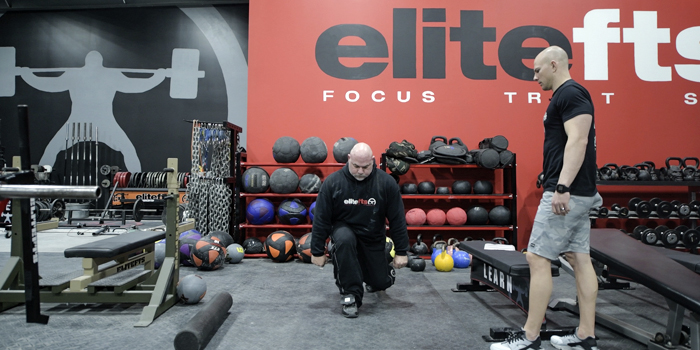
Editor's Note: Fixing Dave Tate is an educational video series intended for demonstration purposes only (acts as a case study specific to Dave Tate). It is not intended to medically diagnose, treat, or manage symptoms. If you are in pain, please consult a licensed healthcare professional.
After two phases of training in the Fixing Dave Tate series, Dr. John Rusin returned to the elitefts headquarters for a 10-week update discussion with Dave. Now that they have checked in and reviewed the previous progress, it's time to make some changes. In this video, Dr. Rusin and Dave break down the lower body training days from the first two phases of training to see what's working, what isn't working, and what needs to change to ensure continued progress. In Dave's current training, there are two lower body days per week: a max effort emphasis day and a dynamic effort emphasis day. Through their discussion, Dr. Rusin and Dave go through these two days separately.
Max Effort Lower Body Training
First, Dr. Rusin and Dave cover the max effort day. Dave begins by pointing out that for the max effort lower body day, he has been performing all of the warm-up work and that the primer has been one of the easier parts of the training to complete. This primer is primarily machine hamstring work, slowly ramping up the load through multiple sets to gradually build a pump before moving on to the heavier training movement. Dave points out that the main benefit of this has been warming up his knees for the rest of the session. After the warm-up and primer, Dave's max effort movements were originally planned to consist of the same movement for three consecutive weeks performed mostly for singles. However, this didn't work for Dave, so he adjusted to rotate the exercise more frequently, which he says enabled him to change the load on the joints each week. He also points out that one of the reasons he continues to do max effort work is for the neuromuscular stabilization of the joints; it doesn't have to be 800 pounds, but being in the 90% range forces him to keep his body tight and synchronize everything. If Dave doesn't change the movement every week for this work, he doesn't make progress.
Dr. Rusin then talks about why single-repetition sets work very well for Dave, based on his lifting history and mature training age that enable him to create maximal amounts of tension. He can create and produce tension incredibly well, but where he falls short is on maintaining that maximal tension throughout the movement or throughout the duration of a set. Increasing Dave's total time under tension by doing moderate or high-rep sets actually puts him at a greater risk of injury, even if the weight is considerably light. This is the exact opposite of what is true for novices and intermediate lifters who lack the neuromuscular capabilities to turn on full body tension. These types of lifters struggle with weights near 100% and are more dangerous in that range, whereas they're relatively safe in the 75% range. This is completely the opposite of Dave. The lesson is that there is no dangerous percentage to train with, but there are certain ranges that put particular lifters at risk.
With this max effort work, Dave points out that he isn't looking for a particular dynamic correspondence; he isn't trying to build a specific lift or increase the weight of one particular movement. He's simply trying to strain and keeps his body capable of doing so. This means that once he reaches the point of straining, there's no reason (other than ego) to push the weight higher. Because his current goal is longevity, his max effort exercise selection isn't based on what will make him stronger at any one movement, but what will keep him progressing from week-to-week on his longevity.
Dr. Rusin points out two options moving forward with this work:
- Alternating hip hinge and squat movement so that each is performed every other week; one week is a hip hinge max effort movement and the next week is a squat max effort movement
- More strategic selection of max effort exercise rotations so that, while still only performing max effort singles, loading increases over the course of three to four weeks
As they continue to work through the details of these options, Dave and Dr. Rusin conclude that moving forward, the max effort movements should include front-loaded work and rotating bars and accommodating resistance, they should begin to load single-leg movement patterns in his assistance work (namely adding weight to the bodyweight reverse lunges), they should continue to use the leg press for hypertrophy work (which Dave says remains very challenging), and they should add accommodating resistance to Dave's hands-elevated push-up hold with alternating hip extension (which Dave has responded to positively thus far) as a finisher. The final part of this training day is Dave's "free time" period to do whatever he wants, which he shares he has used mostly for seated calf raises and banded TKEs to help his knees, and that he will continue to do so as needed.
Dynamic Effort Lower Body Training
The dynamic work on the squat, Dave shares, began with the first three weeks the same weight and increasing the number of sets up to 15 total sets. At that point, he added accommodating resistance and did another three-week wave. Because Dave isn't trying to build his squat, this movement isn't about weight but is instead about finding the right production of force and working to a lower box over time. The goal is to reach the point where he can take his increased transfer of force from his dynamic work and apply it to his heavy work. He has been using an SS Yoke Bar for all of this work and will continue to do so because it is the only bar that he is capable of using regularly, week after week, without issue. Dave has also been using the trap bar deadlift with bands as a second movement on his dynamic effort lower body days, which Dr. Rusin says he wants to continue to include in the program. Moving forward, he says that the goal should be to utilize doubles rather than triples and to increase the pace to 45-second rest intervals rather than 60-second rest intervals. He also reminds Dave that the eccentric phase of the movement is an important component of exercise.
The real change to this training day is going to be the addition of loaded Romanian deadlift variations in the bilateral stance with significant load. These will be performed with dumbbells at a 45-degree hand position, halfway between a neutral side position and anterior loading. Dr. Rusin emphasizes the importance of using a full range of motion and a slow tempo, with a three to four second eccentric. With a rep range of six to 10 reps, each set should have a total time under tension of 40 to 60 seconds.
FIXING DAVE TATE SERIES
- Initial Assessment with Dr. John Rusin
- Movement Screening
- Orthopedic Evaluation
- The Three Areas of Focus Discovered During Initial Evaluation
- Observing Dave's Current Training Capabilities
- Programming the Six-Phase Dynamic Warm-up Sequence
- The Dynamic Warm-Up Sequences for Upper Body and Lower Body
- The 10-Week Update Discussion









